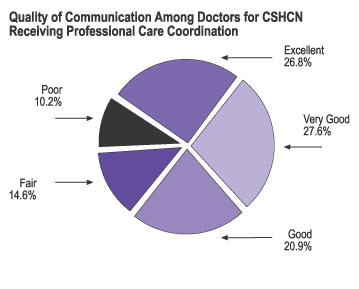 |
 |
 |
Home | Table of Contents | Introduction | Prevalence of CSHCN |
Health and Functional Status of CSHCN | Health Insurance Coverage |
Health Care Needs and Access to Care | Care Coordination | Family-Centered Care | Impact on Families | State Data Pages | Appendix | Footnotes
Care Coordination
In this Section:
Care Coordination and Quality of Communication Among Doctors
Care coordination for children with special health care needs has been defined as “a process that links children with special health care needs and their families to services and resources in a coordinated effort to maximize the potential of children and provide them with optimal health care.”6 Professional care coordination can be essential in assuring that children receive the full range of services they need, that services are not duplicated, and that providers communicate with families and with each other about their patients’ care. Care coordinators also provide critical assistance to families by providing referrals, organizing services, and representing families in care planning meetings. Of course, families may choose to coordinate their children’s care themselves, and many do.
While care coordination can play an important role in the care of CSHCN, not all families who need care coordination report receiving it. This section includes three major indicators of access to and quality of care coordination: the percentage of CSHCN who need professional care coordination; the percentage who need care coordination but do not receive it; and how well families feel that their children’s providers communicate with each other about the child’s care.
Care Coordination and Quality of Communication Among Doctors
*Federal Poverty Level |
|
Parents were asked whether or not they needed professional assistance coordinating their children’s care. Overall, the families of nearly 12 percent of CSHCN reported needing this assistance. This proportion is somewhat higher among poor children (nearly 14 percent) than among the children in the highest-income group (10 percent).
Those who need professional care coordination were also asked whether they received all the care coordination they needed. Overall, the families of 2 percent of CSHCN reported that they needed but did not receive professional care coordination. Again, this proportion varies by income level, from 3.7 percent among children in poverty to 1.4 percent among children from high-income families.
Parents were also asked to rate the quality of communication among their children’s doctors; that is, how well the various providers communicate with each other about the child’s care.
Overall, the parents of more than half of these children felt that communication among their children’s doctors is excellent or very good. The parents of fewer than one-quarter rate the communication among their providers as fair or poor. These proportions do not vary substantially by family income or race/ethnicity.
Previous Section | Next Section
Home | Table of Contents | Introduction | Prevalence of CSHCN |
Health and Functional Status of CSHCN | Health Insurance Coverage |
Health Care Needs and Access to Care | Care Coordination | Family-Centered Care | Impact on Families | State Data Pages | Appendix | Footnotes
 [
[ [
[